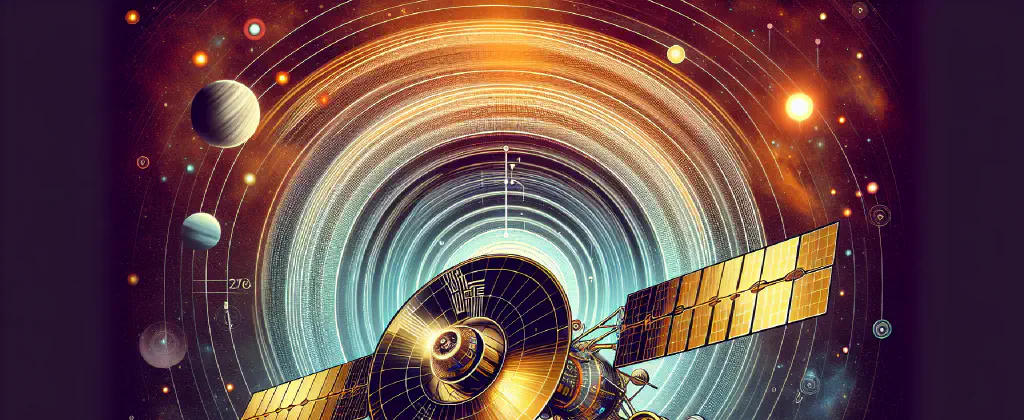14. December 2023
Voyager 1: Decoding the Legends of Communication

Have you ever heard of the tech legend surrounding Voyager 1? The tale goes that when the spacecraft was launched, it carried a Viterbi encoder, even though there supposedly wasn’t a computer on Earth fast enough to decode its transmissions. It’s a captivating story that has inspired engineers and sparked imagination. But is there any truth to this legend? Let’s explore the details and separate fact from fiction.
The Viterbi Encoder and Decoder Myth
The story of Voyager 1’s Viterbi encoder has been circulating for years, intriguing many in the tech community. The essence of the tale is that the Viterbi encoder on Voyager 1 was ahead of its time, with no computer on Earth capable of decoding its transmissions. According to the legend, years later, advancements in computing power made it possible to remotely switch to the more efficient Viterbi decoding.
However, when we delve into the specifics, we find that the legend may not hold true. One commenter clarified that the transmissions from Voyager 1 were recorded on tape, and when decoding was performed, it was not in real time. The recording made in 2015 with the Green Bank Telescope was an example of such decoding. So, the decoding process did not rely on the computational power available at the time of transmission.
Inspiring Engineering and the Power of Legends
Even though the details of the Voyager 1 legend may be murky, it has still inspired engineers and sparked the imagination of many. The commenter who first shared the legend expressed how it motivated them to think outside the box, attempt hard things, and strive to be a better engineer. Legends like these have a way of capturing our attention and encouraging us to push the boundaries of what is possible.
While we may not have the correct details of Voyager 1’s communication encoding and decoding methods at hand, the legend continues to inspire and ignite a sense of curiosity. As the saying goes, sometimes it’s the journey that matters more than the destination.
The Complexity of Error Correction
One crucial aspect of Voyager 1’s communication system is the use of error correction techniques. The spacecraft employed a redundant convolutional code, which allowed for error detection and correction. As the signal traveled further from Earth, the strength degraded, making error correction more challenging.
One commenter explained that the Viterbi decoder, while computationally expensive, was effective at correcting higher error rates compared to other coding schemes. The convolutional code used was valuable throughout the mission. It is possible that different levels of redundancy were employed as the transmission error rate increased.
The interplay between encoding and decoding can be seen in other domains as well, such as optical drives. Commenters brought up the analogy of CD drives that could write at higher speeds but read at slower rates. The time required for writing (burning) a CD was longer than reading it, as the laser needed to heat the disc’s surface to write data. While reading only involved observing reflections.
It’s fascinating to observe how different stages of the data transmission process can have varying complexities, whether it’s encoding versus decoding or writing versus reading.
Duality of Encoding and Decoding
The discussion expanded to the duality of encoding and decoding in various contexts. Another commenter highlighted the difference between video codecs like h264 or VP9. Decoding these codecs simply entails following an algorithm, while encoding involves identifying patterns and optimizing the data representation to save bits. This duality is found across the spectrum of compact encoding (compression) and redundant encoding (error detection and correction).
Encoding and decoding techniques continue to evolve, driven by advancements in computing power and the quest for efficient and reliable data transmission. The balance between complexity, computational resources, and error correction capabilities shapes the design choices made in various communication systems.
Legends, Myths, and the Power of Stories
Despite the uncertainties surrounding the Voyager 1 legend, there is value in tales that capture our imagination, inspire us to explore new frontiers, and push the boundaries of what is possible. Legends and myths have a way of driving us to seek answers, experiment, and strive for greatness.
As we venture into the realm of technology and engineering, let’s embrace the power of stories, tales, and legends. They remind us of the human spirit of curiosity, innovation, and imagination. So, whether the Voyager 1 legend turns out to be true or not, let it inspire us to embark on our own journeys of discovery and push the limits of what we can achieve.
🚀 To infinity and beyond! 🌌